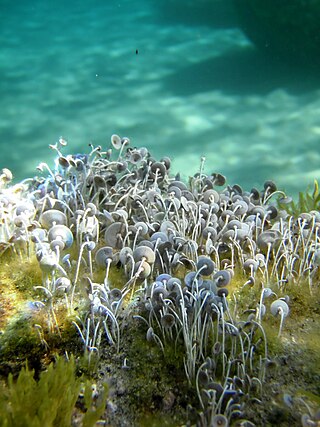
Acetabularia is a genus of green algae in the family Polyphysaceae. Typically found in subtropical waters, Acetabularia is a single-celled organism, but gigantic in size and complex in form, making it an excellent model organism for studying cell biology. In form, the mature Acetabularia resembles the round leaves of a nasturtium, is 4 to 10 centimetres tall and has three anatomical parts: a bottom rhizoid that resembles a set of short roots; a long stalk in the middle; and a top umbrella of branches that may fuse into a cap. Unlike other giant unicellular organisms, which are multinucleate, members of this genus possess a single nucleus located in the rhizoid, which allows the cell to regenerate completely if its cap is removed. The caps of two Acetabularia may also be exchanged, even from two different species. In addition, if a piece of the stem is removed, with no access to the nucleus in the rhizoid, this isolated stem piece will also grow a new cap.
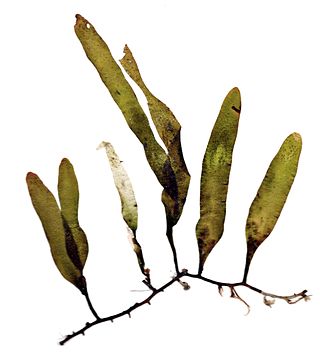
Caulerpa is a genus of seaweeds in the family Caulerpaceae. They are unusual because they consist of only one cell with many nuclei, making them among the biggest single cells in the world.

Halimeda is a genus of green macroalgae. The algal body (thallus) is composed of calcified green segments. Calcium carbonate is deposited in its tissues, making it inedible to most herbivores. However one species, Halimeda tuna, was described as pleasant to eat with oil, vinegar, and salt.
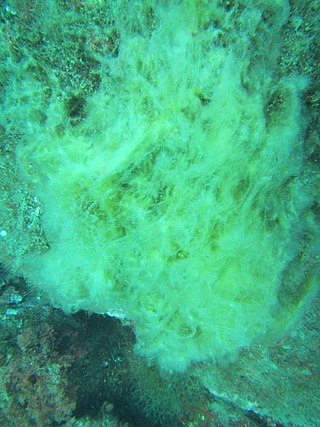
Pelagophycidae is a subclass of heterokont algae.It is the sister group of the axodines. Together, they form the class Dictyochophyceae.
Acrochaete is a genus of marine green algae of the family Ulvellaceae known to live as endoparasites of other algae, although they may eventually be found growing on inorganic substrates, such as rocks.
Atractomorpha is a genus in the Sphaeropleaceae, a family of green algae. The genus name is derived from Greek and means "spindle-shaped" or "arrow-shaped", and refers to the shape of the cells.
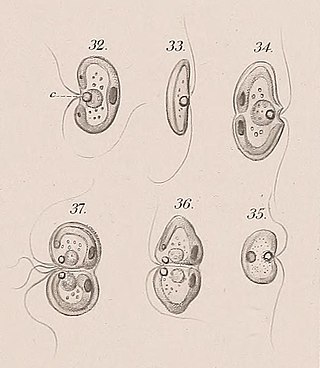
Nephroselmis is a genus of green algae. It has been placed in the family Nephroselmidaceae, although a 2009 study suggests that it should be separated into its own class, Nephroselmidophyceae. One species can be an endosymbiont of Hatena arenicola.
Trichosarcina is a genus of green algae in the order Ulotrichales. Filoprotococcus was once regarded as a synonym. However, Filoprotococcus is now considered valid in its own right. Trichosarcina is considered to be of uncertain validity.

Ochrophytes, also known as heterokontophytes or stramenochromes, are a group of algae. They are the photosynthetic stramenopiles, a group of eukaryotes, organisms with a cell nucleus, characterized by the presence of two unequal flagella, one of which has tripartite hairs called mastigonemes. In particular, they are characterized by photosynthetic organelles or plastids enclosed by four membranes, with membrane-bound compartments called thylakoids organized in piles of three, chlorophyll a and c as their photosynthetic pigments, and additional pigments such as β-carotene and xanthophylls. Ochrophytes are one of the most diverse lineages of eukaryotes, containing ecologically important algae such as brown algae and diatoms. They are classified either as phylum Ochrophyta or Heterokontophyta, or as subphylum Ochrophytina within phylum Gyrista. Their plastids are of red algal origin.
In algal anatomy, a pit connection is a hole in the septum between two algal cells, and is found only in multicellular red algae − specifically in the subphylum Eurhodophytina, except haploid Bangiales. They are often stoppered with proteinaceous "pit plugs". By contrast, many fungi contain septal pores − an unrelated phenomenon.

Rhodochorton is a genus of filamentous red alga adapted to low light levels. It may form tufts or a thin purple "turf" up to 5 millimetres high. The filaments branch infrequently, usually at the tips.

Karenia is a genus that consists of unicellular, photosynthetic, planktonic organisms found in marine environments. The genus currently consists of 12 described species. They are best known for their dense toxic algal blooms and red tides that cause considerable ecological and economical damage; some Karenia species cause severe animal mortality. One species, Karenia brevis, is known to cause respiratory distress and neurotoxic shellfish poisoning (NSP) in humans.
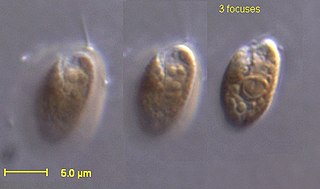
Rhodomonas is a genus of cryptomonads. It is characterized by its red colour, the square-shaped plates of its inner periplast, its short furrow ending in a gullet, and a distinctly shaped chloroplast closely associated with its nucleomorph. Historically, Rhodomonas was characterized by its red chloroplast alone, but this no longer occurs as its taxonomy has become increasingly based on molecular and cellular data. Currently, there is some debate about the taxonomic validity of Rhodomonas as a genus and further research is needed to verify its taxonomic status. Rhodomonas is typically found in marine environments, although freshwater reports exist. It is commonly used as a live feed for various aquaculture species.

Karlodinium is a genus of athecate dinoflagellates that lives worldwide. They are often toxin producing, and compared to the other members of the Kareniaceae, are fairly small at <8-15 µm diameter. They are also able to form intense algal blooms. This species relies of photosynthesis and phagotrphy to grow.

Ornithocercus is a genus of planktonic dinoflagellate that is known for its complex morphology that features considerable lists growing from its thecal plates, giving an attractive appearance. Discovered in 1883, this genus has a small number of species currently categorized but is widespread in tropical and sub-tropical oceans. The genus is marked by exosymbiotic bacteria gardens under its lists, the inter-organismal dynamics of which are a current field of research. As they reside only in warm water, the genus has been used as a proxy for climate change and has potential to be an indicator species for environmental change if found in novel environments.

Gambierdiscus is a genus of marine dinoflagellates that produce ciguatoxins, a type of toxin that causes the foodborne illness known as ciguatera. They are usually epiphytic on macroalgae growing on coral reefs.

Triparma is a genus of unicellular algae in the family Triparmaceae in the order Parmales. They form siliceous plates on the cell surface that aid in identification. Triparma is distinguished by its possession of three shield plates, three triradiate girdle plates, a triradiate girdle plate with notched ends, and a small ventral plate. It was first described by Booth & Marchant in 1987 and the holotype is Triparma columacea.
Coolia is a marine dinoflagellate genus in the family Ostreopsidaceae. It was first described by Meunier in 1919. There are currently seven identified species distributed globally in tropical and temperate coastal waters. Coolia is a benthic or epiphytic type dinoflagellate: it can be found adhered to sediment or other organisms but it is not limited to these substrates. It can also be found in a freely motile form in the water column. The life cycle of Coolia involves an asexual stage where the cell divides by binary fission and a sexual stage where cysts are produced. Some of the species, for example, Coolia tropicalis and Coolia malayensis, produce toxins that can potentially cause shellfish poisoning in humans.
Lepidodinium is a genus of dinoflagellates belonging to the family Gymnodiniaceae. Lepidodinium is a genus of green dinoflagellates in the family Gymnodiniales. It contains two different species, Lepidodiniumchlorophorum and Lepidodinium viride. They are characterised by their green colour caused by a plastid derived from Pedinophyceae, a green algae group. This plastid has retained chlorophyll a and b, which is significant because it differs from the chlorophyll a and c usually observed in dinoflagellate peridinin plastids. They are the only known dinoflagellate genus to possess plastids derived from green algae. Lepidodinium chlorophorum is known to cause sea blooms, partially off the coast of France, which has dramatic ecological and economic consequences. Lepidodinium produces some of the highest volumes of Transparent Exopolymer Particles of any phytoplankton, which can contribute to bivalve death and the creation of anoxic conditions in blooms, as well as playing an important role in carbon cycling in the ocean.
Susan Brawley is an American marine ecologist at the University of Maine known for her research on algae, especially algal reproduction. She was elected a fellow of the American Association for the Advancement of Science in 2012.












